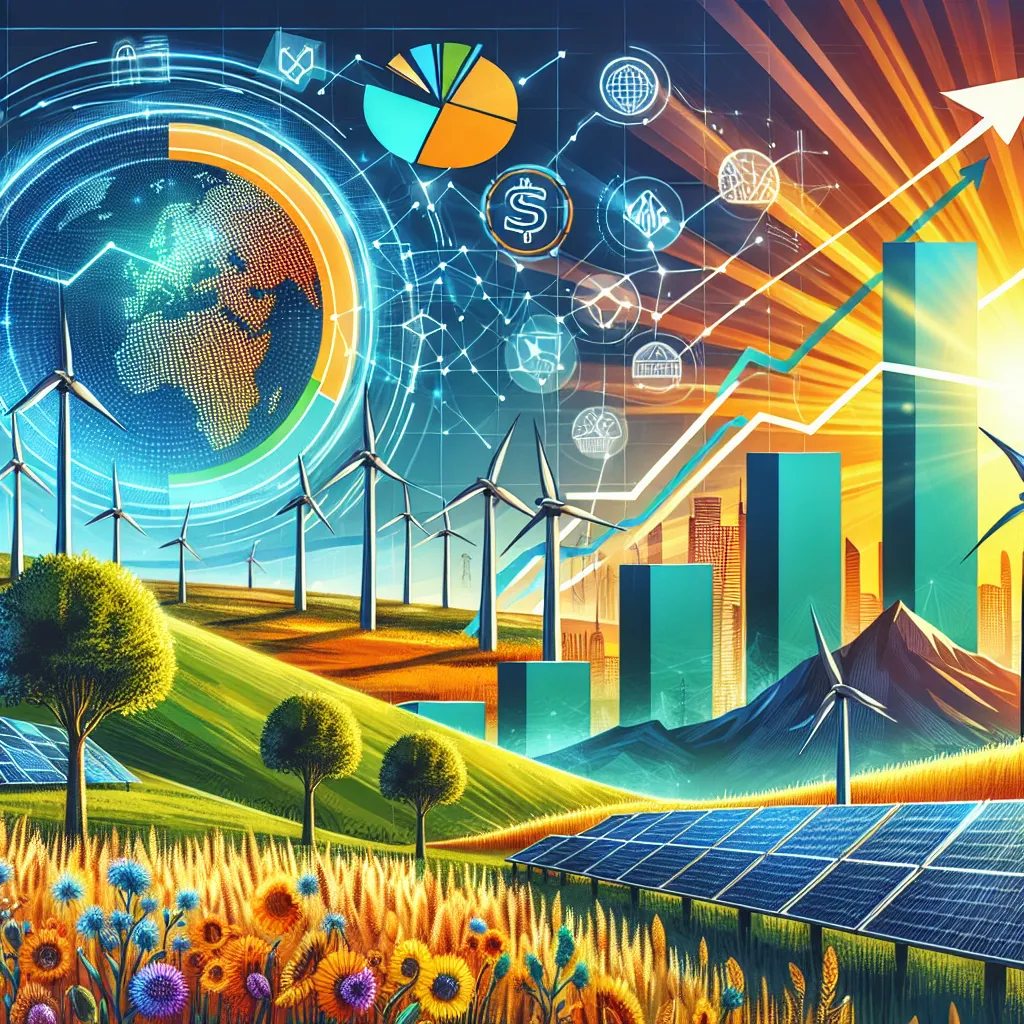Welcome to our IELTS Reading practice test focused on the topic “How Renewable Energy is Driving Economic Development.” This comprehensive test will help you prepare for the IELTS Reading section while exploring an important global issue. Let’s dive into the passages and questions to enhance your reading skills and knowledge about renewable energy’s impact on economic growth.
 Renewable Energy Economic Growth
Renewable Energy Economic Growth
Passage 1 – Easy Text
The Rise of Renewable Energy in the Global Economy
Renewable energy has become a driving force in economic development worldwide. As countries seek to reduce their carbon footprint and achieve energy independence, investments in clean energy technologies have surged. This shift towards sustainable power sources is not only benefiting the environment but also creating new jobs and stimulating economic growth.
Solar and wind power have emerged as the frontrunners in the renewable energy sector. The cost of these technologies has plummeted in recent years, making them increasingly competitive with traditional fossil fuels. This price reduction has led to a boom in installations, with many countries setting ambitious targets for renewable energy adoption.
The economic impact of this transition is substantial. The renewable energy industry has created millions of jobs globally, from manufacturing solar panels and wind turbines to installing and maintaining these systems. Moreover, the localized nature of renewable energy production has helped to distribute economic benefits more evenly across regions, often revitalizing rural areas.
Developing nations are particularly benefiting from this trend. Many of these countries are leapfrogging traditional energy infrastructure and moving directly to renewable sources. This approach not only provides cleaner energy but also reduces dependence on expensive fossil fuel imports, freeing up resources for other economic development initiatives.
As the world continues to grapple with climate change, the role of renewable energy in driving economic development is likely to grow. Governments and businesses are increasingly recognizing that investing in clean energy is not just an environmental imperative but also a smart economic strategy for the future.
Questions 1-5
Choose the correct letter, A, B, C, or D.
-
What is the main factor driving the adoption of renewable energy globally?
A) Reduced carbon footprint
B) Energy independence
C) Job creation
D) Both A and B -
Which renewable energy sources are mentioned as leaders in the sector?
A) Solar and hydro
B) Wind and geothermal
C) Solar and wind
D) Biomass and tidal -
How has the cost of renewable energy technologies changed in recent years?
A) Increased significantly
B) Remained stable
C) Decreased slightly
D) Plummeted -
What is one way renewable energy production benefits rural areas?
A) By centralizing economic activity
B) By distributing economic benefits more evenly
C) By reducing agricultural productivity
D) By increasing urbanization -
How are developing nations approaching renewable energy adoption?
A) By slowly phasing out fossil fuels
B) By importing more renewable technology
C) By leapfrogging traditional energy infrastructure
D) By focusing solely on solar power
Questions 6-10
Complete the sentences below.
Write NO MORE THAN TWO WORDS from the passage for each answer.
-
The renewable energy industry has created millions of ____ globally.
-
The ____ of renewable energy production helps distribute economic benefits across regions.
-
Developing nations are reducing their dependence on expensive ____ imports.
-
Investing in clean energy is seen as both an environmental ____ and a smart economic strategy.
-
The transition to renewable energy is helping countries achieve energy ____.
Passage 2 – Medium Text
Economic Transformation through Green Energy Initiatives
The global shift towards renewable energy is catalyzing a profound economic transformation. As nations strive to meet their climate commitments and secure sustainable energy futures, the renewable sector is emerging as a powerful engine of economic growth and innovation. This transition is not merely about replacing one energy source with another; it’s about reimagining entire economic systems and industrial processes.
One of the most significant impacts of renewable energy on economic development is its role in job creation. The International Renewable Energy Agency (IRENA) reports that the sector employed 11.5 million people globally in 2019, a figure that continues to grow. These jobs span a wide range of skills and sectors, from research and development to manufacturing, installation, and maintenance. Importantly, many of these jobs are being created in regions that have traditionally relied on fossil fuel industries, helping to mitigate the economic impact of the transition away from coal, oil, and gas.
The renewable energy sector is also driving innovation and technological advancements. As companies compete to develop more efficient and cost-effective clean energy solutions, they are spurring breakthroughs in fields such as energy storage, smart grids, and advanced materials. This innovation ecosystem is attracting significant investment and creating new industry clusters, further stimulating economic growth.
Moreover, the decentralized nature of many renewable energy systems is reshaping local economies. Unlike large, centralized fossil fuel plants, renewable energy projects can be scaled to fit community needs, from small rooftop solar installations to larger wind farms. This flexibility allows for more localized energy production and consumption, keeping energy dollars within communities and fostering local economic resilience.
The economic benefits of renewable energy extend beyond the energy sector itself. As businesses and industries adopt cleaner energy sources, they often see improvements in efficiency and reductions in operating costs. This increased competitiveness can lead to growth and job creation in various sectors of the economy.
Furthermore, the transition to renewable energy is opening up new opportunities for international cooperation and trade. Countries with abundant renewable resources are emerging as new energy exporters, while nations with advanced clean technologies are finding new markets for their products and expertise. This shifting geopolitical landscape is creating new economic partnerships and development opportunities.
However, the economic transition to renewable energy is not without challenges. It requires significant upfront investment in infrastructure and technology, as well as policies to support the shift and manage the transition for workers in traditional energy sectors. Despite these hurdles, the long-term economic benefits of embracing renewable energy are becoming increasingly clear, making it a cornerstone of sustainable economic development strategies worldwide.
Questions 11-14
Choose the correct letter, A, B, C, or D.
-
According to the passage, what is the primary role of renewable energy in economic transformation?
A) Replacing fossil fuels
B) Creating jobs in traditional industries
C) Driving economic growth and innovation
D) Reducing energy consumption -
How many people were employed in the renewable energy sector globally in 2019, according to IRENA?
A) 5.5 million
B) 7.5 million
C) 9.5 million
D) 11.5 million -
What aspect of renewable energy systems is reshaping local economies?
A) Their centralized nature
B) Their decentralized nature
C) Their high maintenance costs
D) Their reliance on imported technology -
Which of the following is NOT mentioned as a challenge in the transition to renewable energy?
A) Significant upfront investment
B) Need for supportive policies
C) Managing workforce transition
D) Lack of public support
Questions 15-20
Complete the summary below.
Choose NO MORE THAN TWO WORDS from the passage for each answer.
The transition to renewable energy is driving economic transformation through various mechanisms. It’s creating jobs across multiple sectors, from 15)____ to maintenance. The competition in the sector is spurring 16)____ and technological advancements, attracting investment and creating new industry clusters. The 17)____ of renewable energy systems allows for more localized energy production, which benefits local economies. Adopting cleaner energy often leads to improved 18)____ and reduced operating costs for businesses. On an international scale, the shift is creating new opportunities for 19)____ and trade, with some countries becoming new energy exporters. Despite challenges, the long-term 20)____ of embracing renewable energy are becoming increasingly evident.
Passage 3 – Hard Text
The Multifaceted Impact of Renewable Energy on Global Economic Structures
The proliferation of renewable energy technologies is engendering a paradigm shift in global economic structures, with ramifications extending far beyond the energy sector itself. This transition is not merely a technological upgrade but a fundamental reorganization of economic systems, challenging long-established patterns of production, consumption, and international relations. The multifaceted impact of this shift is reshaping industries, altering geopolitical dynamics, and redefining the parameters of economic development and sustainability.
At the forefront of this transformation is the decarbonization of energy-intensive industries. Sectors such as manufacturing, transportation, and construction, which have traditionally been major contributors to greenhouse gas emissions, are increasingly adopting renewable energy solutions. This shift is not only reducing their environmental footprint but also driving innovation in process efficiency and product design. For instance, the steel industry, one of the largest industrial emitters of CO2, is experimenting with hydrogen-based production methods powered by renewable electricity, potentially revolutionizing a sector that has seen little change in its core processes for decades.
The integration of renewable energy into industrial processes is catalyzing the emergence of new economic models. The concept of circular economy, which aims to eliminate waste and maximize resource efficiency, is gaining traction as renewable energy enables more sustainable production cycles. This approach is fostering new business models centered around resource recovery, remanufacturing, and product-as-service offerings, creating novel economic opportunities while addressing environmental challenges.
Moreover, the distributed nature of many renewable energy systems is democratizing energy production and consumption. This decentralization is empowering communities and individuals to become energy producers, blurring the lines between consumers and suppliers in the energy market. The rise of prosumers – individuals who both produce and consume energy – is challenging traditional utility business models and necessitating regulatory reforms to accommodate these new market dynamics.
The renewable energy transition is also reconfiguring global trade patterns and economic power structures. Countries rich in renewable resources, such as solar and wind potential, are emerging as new energy superpowers, while those historically dependent on fossil fuel exports are facing the imperative to diversify their economies. This shift is altering the geopolitical landscape, potentially reducing conflicts related to fossil fuel resources while creating new forms of economic interdependence based on clean energy technologies and expertise.
Furthermore, the renewable energy sector is becoming a significant driver of technological innovation and knowledge-based economic growth. Investments in research and development for renewable technologies are spurring advancements in fields such as materials science, energy storage, and grid management. These innovations often have spillover effects, benefiting other sectors of the economy and contributing to overall productivity gains.
The financial sector is also undergoing a transformation in response to the renewable energy revolution. The concept of sustainable finance is gaining prominence, with investors increasingly incorporating environmental, social, and governance (ESG) criteria into their decision-making processes. This shift is channeling capital towards renewable energy projects and clean technologies, while also pressuring traditional industries to adapt to low-carbon business models.
However, the transition to a renewable energy-based economy is not without its challenges. The intermittent nature of some renewable sources necessitates significant investments in energy storage and grid infrastructure. Additionally, the rapid pace of technological change in the sector can lead to stranded assets in fossil fuel industries, potentially causing economic disruptions in regions heavily dependent on these sectors.
Despite these challenges, the economic opportunities presented by the renewable energy transition are substantial. From job creation in new industries to improved energy security and reduced environmental externalities, the shift towards renewable energy is increasingly seen as a key driver of sustainable economic development. As this transition accelerates, it is reshaping the global economic landscape, offering both challenges and opportunities for nations, businesses, and individuals to adapt and thrive in a new energy paradigm.
Questions 21-26
Complete the summary below.
Choose NO MORE THAN THREE WORDS from the passage for each answer.
The transition to renewable energy is causing a 21)____ in global economic structures. This shift is leading to the 22)____ of energy-intensive industries and the emergence of new economic models such as the 23)____. The distributed nature of renewable energy systems is creating 24)____, who both produce and consume energy. This transition is also altering global trade patterns and empowering countries rich in 25)____. The financial sector is adapting through the rise of 26)____, which incorporates ESG criteria into investment decisions.
Questions 27-32
Do the following statements agree with the information given in the passage?
Write
TRUE if the statement agrees with the information
FALSE if the statement contradicts the information
NOT GIVEN if there is no information on this
-
The steel industry is exploring hydrogen-based production methods powered by renewable electricity.
-
The circular economy concept is incompatible with renewable energy systems.
-
Prosumers are challenging traditional utility business models.
-
Countries dependent on fossil fuel exports are rapidly transitioning to renewable energy production.
-
The renewable energy sector is contributing to technological innovations in other fields.
-
The intermittent nature of renewable sources is a minor challenge that can be easily overcome.
Questions 33-40
Complete the sentences below.
Write NO MORE THAN TWO WORDS from the passage for each answer.
-
The transition to renewable energy is not just a technological upgrade but a ____ of economic systems.
-
The ____ of energy-intensive industries is at the forefront of the economic transformation driven by renewable energy.
-
The concept of ____ aims to eliminate waste and maximize resource efficiency in production cycles.
-
The rise of individuals who both produce and consume energy, known as ____, is challenging traditional energy market structures.
-
Countries with abundant renewable resources are emerging as new ____ in the global energy landscape.
-
Investments in renewable technologies are spurring advancements in fields such as ____ and grid management.
-
The rapid pace of technological change in the renewable sector can lead to ____ in fossil fuel industries.
-
Despite challenges, the transition to renewable energy is seen as a key driver of ____ economic development.
Answer Key
Passage 1
- D
- C
- D
- B
- C
- jobs
- localized nature
- fossil fuel
- imperative
- independence
Passage 2
- C
- D
- B
- D
- research and development
- innovation
- decentralized nature
- efficiency
- cooperation
- economic benefits
Passage 3
- paradigm shift
- decarbonization
- circular economy
- prosumers
- renewable resources
- sustainable finance
- TRUE
- FALSE
- TRUE
- NOT GIVEN
- TRUE
- FALSE
- fundamental reorganization
- decarbonization
- circular economy
- prosumers
- energy superpowers
- materials science
- stranded assets
- sustainable
This IELTS Reading practice test has provided a comprehensive exploration of how renewable energy is driving economic development. By working through these passages and questions, you’ve not only enhanced your reading skills but also gained valuable insights into the global shift towards sustainable energy sources and its wide-ranging economic impacts.
Remember to analyze your performance, focusing on areas where you struggled. Pay attention to time management, as the IELTS Reading test requires you to complete all questions within 60 minutes. Practice regularly with various question types and topics to improve your speed and accuracy.
For more IELTS preparation resources, check out our articles on how renewable energy is transforming transportation infrastructure and the impact of clean energy on developing nations. These will provide additional context and vocabulary related to renewable energy and economic development, which can be beneficial for your IELTS preparation.
Keep practicing, and good luck with your IELTS journey!


